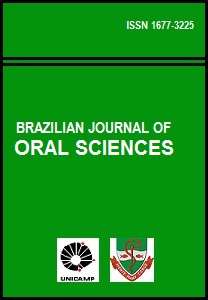Abstract
Aim: To determine the association between dental caries, Body Mass Index (BMI) and sugar intake in children attending primary school. Methods: A cross-sectional study was conducted with 91 children, with mean age of 3.9 years (sd = ±1.0), considering anthropometric measurements, according to standardized methodology of the Ministry of Health and occurrence of dental caries was recorded from clinical examinations (dmft). The sugar intake level was measured with a questionnaire that was applied to parents/caretakers of the children. The association of the variables was checked using a correlation with the Contingency C coefficient test. Results: 33 (36.3%) children were at risk for overweight, overweight or obese. Of these, 10 (30.3%) had dmft >1. An association was found between sugar added to the bottle and child dmft (coeff. C = 0.5853 and p <0.0001) and also with BMI (coeff. C = 0.5693 and p <0.0001). There was no association between BMI and caries (chisquare = 0.1447 and p-value = 0.7036). Conclusions: It was concluded that there was a correlation between sugar intake and dmft and BMI, but not between caries and BMI.
This work is licensed under a Creative Commons Attribution 4.0 International License.
Copyright (c) 2015 Ronald Jefferson Martins, Suzely Adas Saliba Moimaz, Mirelli Ramiro Silva, Orlando Saliba, Clea Adas Saliba Garbin
Downloads
Download data is not yet available.

